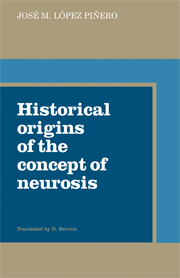1 - The concept of neurosis
Published online by Cambridge University Press: 06 August 2010
Summary
The concept of ‘neurosis’ was coined by William Cullen, the Scottish physician, and appeared first in his Synopsis Nosologiae Methodicae (1769) and then in his First Lines of the Practice of Physick (1777). In studies published between 1835 and 1841 three followers of the German Romanticism have disagreed with this fact and attributed the term to Felix Platter, the Swiss physician of the Renaissance. This dissenting view, however, is based upon a misinterpretation of the term ‘functionum laesiones’, utilized by Platter in his treatise of practical medicine. For Cullen the term ‘neurosis’ was no more than a useful neologism with which to refer to ‘nervous disease’, a concept current in the medicine of his time. Its meaning then, vastly different from the one in usage nowadays, embodies a view of neurosis that had currency before its anatomoclinical re-interpretation.
That the term ‘nervous disease’ had originated a century before was common knowledge amongst the writers who modified it during the second half of the eighteenth century and a number of studies available during Cullen's time echoed views from a British tradition that had been started by Willis and Sydenham. Cullen stated in Synopsis (IV, p. 182) ‘Since the time of Willis, British physicians have grouped some diseases under the category of nervous’. The Swiss Simon André Tissot, reported in his Traité des Nerves et de leurs Maladies (1778) (written 10 years earlier): ‘Sydenham… was the first to remark on the protean character of the nervous disease and to suggest that its symptoms might result from a disturbance in nervous function’.
- Type
- Chapter
- Information
- Historical Origins of the Concept of Neurosis , pp. 1 - 24Publisher: Cambridge University PressPrint publication year: 1983
- 1
- Cited by



